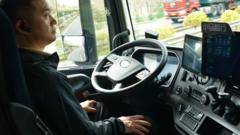On the highways between Beijing and Tianjin, a fleet of driverless lorries is making waves in China's transport sector, showcasing a potential revolution in logistics. While a safety driver remains in place due to regulations, these trucks demonstrate the ability to navigate public roads autonomously. Huo Kangtian, a safety driver, recounts his initial apprehension transforming into confidence as he observes the technology's capabilities, allowing him to focus on other tasks.
The vice-president of Pony AI, Li Hengyu, envisions a future where driverless operations significantly enhance transport efficiency, reducing labor costs and easing the strain of long hours on drivers. Yang Ruigang, a technology scholar, reinforces this perspective, noting that any technology that curtails operational expenses is attractive for companies.
However, concerns linger over the public's acceptance of autonomous vehicles, especially in light of past accidents involving self-driving cars, which have raised alarms. Chim Lee from the Economist Intelligence Unit recognizes the importance of public perception in navigating the future of driverless technology.
In Hefei, a city in Eastern China where driverless delivery vans have become common, companies like Rino.ai are capitalizing on the efficiency gains. They utilize autonomous vehicles for longer distances while human couriers handle local deliveries, optimizing the supply chain. Rino's presence in over 50 cities and its upcoming deployment in Australia indicate a growing interest in this market.
Yet, industry experts caution that while fully autonomous heavy trucks on highways may still be several years away, the potential for limited autonomy exists in controlled environments. Implementing these vehicles presents challenges in sensor technology and public trust, as people tend to hold machines to a higher standard than human drivers.
China's stakes are high. Precautions need to be in place to ensure public safety and foster acceptance of autonomous technology. As regulatory measures evolve, the interplay between innovation and caution will define the path forward for the nation's ambitious drive into driverless trucking.



















